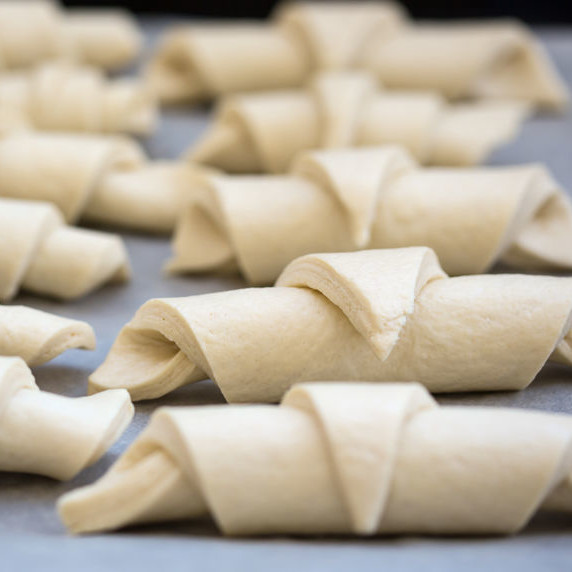Pastry Shortening
Also known as roll-in or fill-in fat for laminated products
What is Pastry Shortening?
A pastry shortening is a firm yet malleable specialty fat used in laminated bakery products. It is made of solid and liquid fat blends at a precise ratio or solid fat index (SFI). It can be manufactured from plant or animal sources.
Unlike the all-purpose version, pastry shortening is typically stable and does not flow or deform with its own weight. So it doesn’t crack when stress is applied during dough sheeting and folding. Pastry shortening is used in products such as:
- Danish pastry
- Puff pastry
- Croissant rolls
Function
Pastry shortenings used as fill-in or roll-in materials are different from their all-purpose counterparts, which are added directly to the dough during mixing. Pastry varieties are specially formulated to be plastic or semi-solid with a defined polymorphic structure (β′ crystals) in a broad temperature range under standard pastry processing conditions. These characteristics are important factors that promote an excellent rise or “puff” during baking, and a light, flaky texture in the finished products.
Roll-in shortenings usually contain high levels of tri-saturated and tri-unsaturated triacylglycerols and high SFI. Bakers can usually judge the suitability of a shortening subjectively using the “thumb and finger” tactile test and by visually observing its deformation.
Some of the physical parameters that are considered essential for good pastry shortening functionality include higher solid fat content and melting points, ß’ polymorphic structure and high yield values in a specific temperature range.
Application
Chemical and physical specifications for pastry shortenings:1,2
- Moisture, 0% (anhydrous)
- Free fatty acids (FFA as oleic acid), 0.05% max. This value helps determine stability. High levels indicate inadequate refining or fat breakdown.
- Phosphorus content, 1 ppm max
- Peroxide value (milliequivalent/Kg), 1.0 max
- Baking stability: Baking performance often judged by the development of off-flavors in the finished product.
| Property (quality parameter) | Pastry shortening |
| Consistency | Firm, waxy and smooth |
| Application | Danish, puff pastry, croissant |
| Solid fat profile (SFI)1,2 | |
| At 50°F (10°C)
Retarder or refrigeration temperature |
26 |
| At 70°F (21°C)
Mixing and makeup temperature |
24 |
| 80°F (27°C) | 19 |
| 92°F (33°C) Proofing temperatures | 17 |
| 104°F (40°C) | 14 |
| Plastic range* | 15 < SFI < 25 SFI > 25 (too brittle)
SFI < 15 (too fluid) |
| Melting point | 115–135°F (47–57°C) |
* Plastic pastry shortenings are comprised of a solid and a liquid phase. The range of temperatures at which the SFI values remain within the 15–25% solids is referred to as the plastic range.
Relevant considerations
- As a general rule, the melting point of pastry shortenings should be at least 9°F (5°C) higher than the proofing temperature of Danish and croissants (90–95oF / 32–35oC) to prevent oil-out and dough fat absorption. Fat melting results in loss of flakiness in the baked goods.
- Pastry shortenings of very high melting points are not recommended as these may create a waxy mouthfeel and may tear the dough once the baked product is cooled.
- For proper performance during lamination and folding, hold fat (temper) at application temperature (about 77°F or 25°C) for 24 hr before use. Dough should be retarded before rolling in.
Nutrition and health
Earlier pastry shortenings were sourced from animal fats or partially hydrogenated vegetable oils (PHVO). Concerns with trans-fats generated from PHVO’s and their implications in inflammation and coronary heart disease led the industry to seek other alternatives.4
To mitigate this undesirable effect, newer versions of pastry shortenings are based on palm oil, a naturally semi-solid fat and can be obtained from sustainable sources. Another advantage of these vegetable-based pastry shortenings is their suitability for vegetarians.
Typical composition of vegetable-oil based pastry shortening (%):
| Component | % |
| Total fat | 100.0 |
| Saturated fat | 53.0 |
| Polyunsaturated fat | 9.0 |
| Monounsaturated fat | 37.0 |
| Cholesterol | 0.0 |
FDA regulation
Unlike butter and margarine used in pastry as roll-in fats, pastry shortenings do not have a Standard of Identity established by the FDA. This means their composition and processing are not regulated to meet specific legal criteria.
References
- O’Brien, R.D. “Baking Shortenings.” Fats and Oils: Formulating and Processing for Applications, 3rd edition, CRC Press, Taylor & Francis Group, LLC, 2009, pp. 361–394.
- Stauffer, C.E. “Bakery Product Applications.” Fats and Oils, Eagan Press Handbook Series, AACC International, Inc., 1996, pp. 61–76.
- O’Brien, R.D. “Shortening Technology.” Introduction to Fats and Oils Technology, 2nd edition, AOCS Press, 2000, pp. 421–445.
- Thompson, A.K., Minihane, A.M. and Williams, C.M. Trans fatty acids and weight gain. Int. J. Obesity, 2011, 35, 3, pp. 315-324


